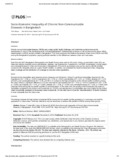| dc.identifier.citation | Biswas, T., Islam, M. S., Linton, N., & Rawal, L. B. (2016). Socio-economic inequality of chronic non-communicable diseases in bangladesh. PLoS ONE, 11(11)10.1371/journal.pone.0167140 | en_US |
| dc.description.abstract | Introduction Chronic non-communicable diseases (NCDs) are a major public health challenge, and undermine social and economic development in much of the developing world, including Bangladesh. Epidemiologic evidence on the socioeconomic status (SES)-related pattern of NCDs remains limited in Bangladesh. This study assessed the relationship between three chronic NCDs and SES among the Bangladeshi population, paying particular attention to the differences between urban and rural areas. Materials and Method Data from the 2011 Bangladesh Demographic and Health Survey were used for this study. Using a concentration index (CI), we measured relative inequality across pre-diabetes, diabetes, pre-hypertension, hypertension, and BMI (underweight, normal weight, and overweight/obese) in urban and rural areas in Bangladesh. A CI and its associated curve can be used to identify whether socioeconomic inequality exists for a given health variable. In addition, we estimated the health achievement index, integrating mean coverage and the distribution of coverage by rural and urban populations. Results Socioeconomic inequalities were observed across diseases and risk factors. Using CI, significant inequalities observed for pre-hypertension (CI = 0.09, p = 0.001), hypertension (CI = 0.10, p = 0.001), pre-diabetes (CI = -0.01, p = 0.005), diabetes (CI = 0.19, p<0.001), and overweight/obesity (CI = 0.45, p<0.001). In contrast to the high prevalence of the chronic health conditions among the urban richest, a significant difference in CI was observed for pre-hypertension (CI = -0.20, p = 0.001), hypertension (CI = -0.20, p = 0.005), pre-diabetes (CI = -0.15, p = 0.005), diabetes (CI = -0.26, p = 0.004) and overweight/obesity (CI = 0.25, p = 0.004) were observed more among the low wealth quintiles of rural population. In the same vein, the poorest rural households had more co-morbidities compared to the richest rural households (p = 0.003), and prevalence of co-morbidities was much higher for the richest urban households compared to the poorest urban households. On the other hand in rural the "disachievement" of health indicators is more noticeable than the urban ones. Conclusion The findings indicate the high burden of selected NCDs among the low wealth quintile populations in rural areas and wealthy populations in urban areas. Particular attentions may be necessary to address the problem of NCDs among these groups. | en_US |

